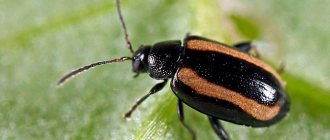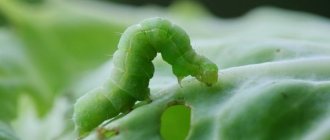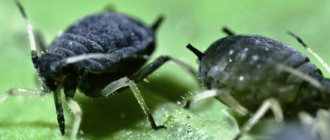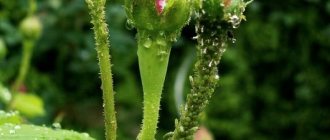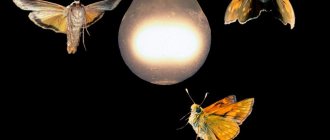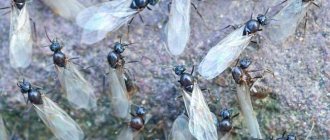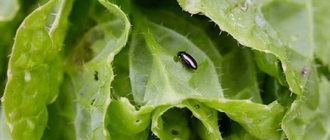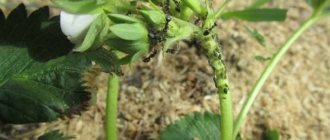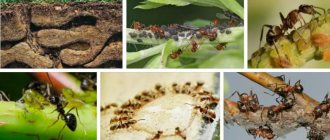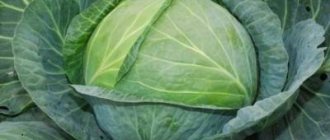Experienced gardeners have already collected a whole collection of measures and tips on how to protect cabbage from flea beetles so as not to be left without a harvest. Agricultural technicians constantly remind about preventive measures: it is easier to prevent than to abandon other gardening chores and fight for cruciferous crops. Agrochemistry offers a full range of drugs to quickly get rid of the scourge.
There is full combat readiness on all fronts, but sooner or later the pest still attacks radishes, cabbage (of all types), fodder root crops, and mustard. Knowing the enemy by sight, they enter the fight at the first sign of a threat.
How dangerous is a flea?
Phyllotreta cruciferae is an agricultural pest, a type of flea beetle from the Leaf Beetle family, devouring cruciferous crops, including cabbage. They are small beetles with a body length of 2-3 mm and jumping limbs. The integumentary coloration depends on the species; usually the black flea beetle may have a greenish or metallic tint, yellow legs or stripes on the elytra.
The tiny bug jumps several meters and moves very quickly.
In the countries of the former Soviet Union, the cabbage flea beetle is widespread wherever there are cultivated or wild plants from the Cruciferous (Cabbage) family. The 4 most common species of Phyllotreta are:
- Nemorum (light-footed) - lives in the south of the forest zone. The flea prefers to gnaw and mine the leaves of cabbage and other cruciferous vegetables.
- Undulata (wavy) is found in the north of the European part, the Far East, the Urals, and Siberia. Adults skeletonize leaves, larvae eat lateral roots.
- Atra (southern or black flea beetle) is the most dangerous pest of cruciferous crops, despite its name, it lives throughout the species’ distribution range. Beetles gnaw the leaves; the larvae prefer small roots.
- Vittata (notched) feeds and parasitizes mainly on oilseed cruciferous crops in the Amur region, Primorye, and southern Yakutia.
Flea beetles overwinter in the ground, under leaves, and in cracks of wooden structures. Before early radishes emerge and cabbage is planted in the ground, they parasitize weedy cruciferous crops:
- rapeseed;
- mustard;
- shepherd's purse;
- Yakut;
- wild radish.
If cabbage seedlings are grown in a poorly treated greenhouse, flea beetles can destroy them before moving them to a permanent location. Pests gnaw holes, sometimes completely skeletonize young leaves, scraping off the skin. Old leaves are hard, covered with a waxy coating, and pests like them much less.
Black flea beetles on Chinese cabbage cause the most harm. Its leaves remain tender until harvest. Often, when you cut a beautiful-looking fork, you can find a whole colony of insects inside.
The larvae develop under the cabbage bush and pupate there. They feed on lateral sucking shoots and often eat up the root collar.
Pests are most active as soon as the temperature rises to 15°C. If spring is warm and early, it is difficult to save cabbage seedlings from flea beetles without using chemicals - they can eat the entire garden bed.
During the rainy season or with frequent watering, the activity of Phyllotreta cruciferae decreases, but pathogenic microorganisms invade damaged leaves. Flea beetles switch to ornamental crops - roses, lilies.
Important! The second generation of pests appears in July.
Danger to cabbage
Tender leaves of young cabbage are a delicacy for voracious cruciferous flea beetles, which attack the crop in early summer and actively eat it. Cabbage is most vulnerable when it is still in the seedling stage, having just been transplanted to a permanent place of residence.
Expert opinion
Stanislav Pavlovich
Gardener with 17 years of experience and our expert
Ask a Question
Pests eat cabbage leaves so that they become like a sieve. The uneaten part of the leaf dries out immediately. As a result, the cabbage does not have time to set a head and dies. If the young seedlings were protected from the invasion of the cruciferous flea beetle, and the heads of cabbage had time to set, and the leaves became tougher, then you no longer need to be afraid of this insect.
Prevention of pest occurrence
Correct agricultural technology will not prevent black flea infestation of cabbage - thanks to its high jumping ability, the insect will get away from its neighbors even over the fence. But this will delay the appearance of the pest and reduce the damage.
Preventive measures:
- compliance with crop rotation;
- dressing cabbage seeds;
- regular weeding;
- digging the beds in the fall - cruciferous flea beetles wintering in the upper layers of the soil will die from frost;
- destruction of plant residues at the end of the season;
- planting garlic, nightshade crops and aromatic plants next to cabbage - their smell repels black flea beetles;
- frequent overhead watering;
- regular fertilizing with organic matter;
- preventative treatments;
- You should not leave cruciferous weeds pulled out or chopped with a hoe in the garden.
White cabbage
The cabbage white is a butterfly that is distinguished by white wings with black spots on them. This pest lays eggs on the underside of Chinese cabbage, from which caterpillars then hatch and feed on the heads and leaves. Insects can gnaw through the plant, causing it to slow down in development and may die.
A solution of liquid soap and wood ash, which needs to be sprayed on the cabbage whites, helps against cabbage whites. It is also recommended to regularly inspect vegetable leaves for eggs and caterpillars. If pests are identified, they should be removed. To combat white cabbage, water Chinese cabbage with a solution of dry mustard, table salt and red pepper.
Some gardeners cover the plantings with a fine mesh, through which butterflies cannot reach the “Peking”.
Chemical control agents
Methods of controlling flea beetles on cabbage depend on the degree of damage to the garden bed. If there are a lot of pests, it is better to immediately turn to chemicals:
- Pochin - used on seedlings and immediately after planting in the garden;
- Alpha-super - emulsion concentrate, enteric-contact insecticide, resistant to washing off, destroys cruciferous flea beetles at all stages, protective effect - up to 3 weeks, waiting period on cabbage (before harvesting) - 1 month;
- PSK - for spraying, use according to the instructions, you can add 100 ml of the drug to a bucket of water, wet rags, spread between the rows of cabbage;
- Lightning Extra;
- Aktara;
- Fufanon-Nova;
- Alatar;
- Carbocin.
Important! If gardeners, when choosing products to treat cabbage against pests, decide to use intestinal preparations, it is recommended to spray in the early morning. At this time, the leaves actively breathe and absorb the insecticide better, therefore, the result will be quick.
The difference between insect damage and disease
Any gardener must be able to distinguish infected plants from those damaged by pests, otherwise the measures he takes will not only not stop the insects, but will also contribute to an increase in their colony.
When a plant is infected with a fungal or viral disease, the following appears on the leaves:
- blackening (alternaria);
- vague spots of gray plaque (peronosporosis);
- wet rot and unpleasant odor (bacteriosis);
- darkening and rotting of the stem (black leg).
Plants look completely different when attacked by insect pests:
- leaves dry out and change their shape;
- Holes in the form of sores and small holes appear on the leaf plates;
- the stems become hollow;
- You can see eaten away grooves on the cuttings and leaf veins.
But you will always find the most important sign if you take a good look at the plant or the soil next to it - these will be insects, the culprits of everything that is happening.
Folk remedies
The appearance of cabbage flea beetles can be prevented without the use of chemicals. It is easy to destroy pests that have already settled on plants using folk methods only at the initial stage - here they will help:
- vinegar;
- infusion of aromatic herbs;
- valerian infusion.
In the event of a mass invasion, it is better to immediately turn to insecticidal preparations. You can also try:
- turpentine (this will make it difficult to work in the garden due to the smell);
- red pepper;
- burnt plant residues (if the head of cabbage has not yet begun to form).
Ash
Dusting with ash is a method of flea control, effective on seedlings, after transplanting cabbage into the ground until the head is tied. As soon as the forks begin to form, you cannot use it, just like tobacco dust - the product will get inside the head of cabbage and will not be washed out.
How to treat flea ash with ash - sequence:
- Water the cabbage by wetting the soil and leaves. If it has just rained, there is no need to carry out additional moistening.
- Pour ash into a whole nylon stocking or a fine sieve. You can mix it with tobacco dust 1:1.
- Dust the plants and the ground underneath them.
Treatment with ash is a very effective way to combat cruciferous flea beetle, but it only works until the next watering or rain.
Herbal infusions
The black flea flea is repelled by many odors, including plant odors. Some gardeners do not use such a simple remedy on cabbage only because they are confused by the recipes - they give the amount of raw materials in kilograms.
It's much easier to do this:
- Fill an enameled or galvanized bucket with chopped plants without roots to 1/10.
- Pour boiling water over it.
- Leave covered for 1-2 days.
Second way:
- To fill with water.
- Bring to a boil, simmer for 10-15 minutes.
- Allow to cool naturally.
The following plants can be used to destroy or repel flea beetles on cabbage:
- garlic arrows;
- tomato or potato tops;
- tobacco;
- pyrethrum;
- dill;
- marigold;
- calendula.
By the time the cabbage is processed in the spring, old garlic has already dried out, but young garlic is expensive, or it’s a pity to use it. The same can be said about red hot pepper. For July treatment against cruciferous flea beetles, they are also used if there are no simpler, cheaper means at hand.
Vinegar
A cabbage bed can be sprayed with flea flea vinegar. A glass of 9% or 2 tbsp is diluted in 10 liters of water. l. essences. But, before you treat cabbage seedlings or plant heads that are ready to set, you should take into account that this will get rid of the pest for several days. Then the operation will have to be repeated or a new product will be used.
Other methods
You can drive the cruciferous flea beetle out of your garden beds using reliable folk remedies. It is important not to be late here - the pest will have time to lay eggs.
White
Sodium hypochlorite (NaClO) will help save cabbage from flea beetles without even getting on the plant:
- Cut old rags into pieces approximately 30 x 30 cm.
- Soak in bleach solution.
- Place on the beds with cabbage at the rate of 1 piece per 1 square meter. m.
- Every day at sunset, wet the cloth with a new portion of NaClO.
Turpentine
If no one walks around the garden with a lit cigarette, and the risk of fire is close to zero, instead of white on the cabbage, you can use turpentine, not only gum (pharmaceutical), but also obtained from petroleum products (construction). Resin-soaked rags are placed on pieces of cellophane, plastic, or boards so that the substance does not migrate into the soil.
Comment! Rags soaked in turpentine retain the smell much longer than those soaked in white.
Slugs
Slugs and snails also cause a lot of damage to Chinese cabbage and can destroy even large plantings in a short time. Their main danger is that they damage both aboveground and underground parts of plants.
To combat slugs using traditional methods, make a mixture of wood ash, table salt, ground red pepper and dry mustard, which is sprinkled on the soil around the “Beijing” on a sunny day, simultaneously loosening the soil. The plant itself is pollinated with wood ash, red pepper and dry mustard. It is recommended to carry out this treatment twice with a break of a week.
Gardening stores sell special anti-slug products that can be used if the number of pests is large and traditional methods do not help eliminate them.
Shampoo rating
There are many different washing products that can rid your pet of parasites. Some contain insecticides so they kill insects completely. Others contain natural extracts that simply repel fleas.
AVZ Bars repellent
This flea shampoo for dogs contains natural clove extract, lavender essential oil, which has a parasite-repellent effect, and other auxiliary components.
The drug is used for regular bathing of dogs. Thanks to it, the wool acquires an odor that parasites do not like, which prevents infection. The shampoo has a softening effect on the skin and relieves the pet from itching.
Price: 220-240 rubles for 250 ml.
RolfClub insecticidal
The main component is permethrin. It effectively kills fleas already during bathing. This product is only suitable for those pets who are already 3 months old.
The amount of gel is calculated based on the weight of the pet: for every kilogram of weight you need to take 0.5-1 ml.
The whipped foam is left on the wool for 5-7 minutes, after which it is washed off with warm water. Then use a fine-toothed comb to comb out the dead parasites.
IMPORTANT! Do not allow foam to get into your pet's eyes or ears.
In order to avoid re-infection, it is recommended to treat all animal bedding. To do this, according to the instructions, the drug is mixed with water in a ratio of 1 to 2 and sprayed on the bed. Consumption rate: 10 ml per square meter. After 3 days, the bedding is washed, dried and given to the dog.
Price: 300-330 rubles per 400 ml.
Mister Bruno insecticidal
The composition includes two active ingredients: pyriproxyfen and fipronil. Together they block the transmission of nerve impulses and disrupt the hormonal balance of fleas, which leads to their rapid death.
The bottle has a special dispenser. With one click you can get 4 ml of gel. The dosage is 1-3 ml for each kilogram of the pet’s weight.
The dog's fur is first moistened with water, and then the required amount of product is applied and whipped into foam. It is left on the dog for 5-7 minutes and then washed off with running water.
The shampoo is contraindicated for puppies under 4 weeks of age. It should also not be used to wash pregnant or lactating animals.
Price: 380-400 rubles for 350 ml.
Celandine BIO
Contains essential oils (rosemary, lavender, tea tree, geranium). These components do not kill fleas, but give the fur a special aroma that repels parasites and prevents infection.
This product is suitable for both small breed pets and pregnant, lactating and weakened dogs. Vitamin E and aloe vera extract relieve itching, moisturize and soften the coat and skin.
Price: 120-150 rubles per 180 ml.
GreenFort Neo BioShampoo
The shampoo contains dimethicone, which immobilizes fleas and causes their death. Essential oils give the coat an aroma that repels any skin parasites, while vitamin E and aloe vera extract have a moisturizing effect.
Application:
- the wool is wetted;
- the gel is whipped into foam and applied to the pet’s entire body;
- After 5-10 minutes, the foam is washed off well with water.
REFERENCE! The product is safe for pregnant and weakened dogs. It can be used to wash small puppies (from 4 weeks of age). The shampoo is considered hypoallergenic, so it is suitable for pets suffering from allergies.
Price: 300-350 rubles for 380 ml.
Beaphar Bio
The composition includes components such as pyrethrum, lavender and margosa extract. The shampoo has a detrimental effect on fleas and prevents re-infection of the pet. It is suitable for dogs with sensitive skin.
The product has an age limit. It is used to wash adult animals and puppies that are already 12 weeks old (3 months old).
Price: 800-900 rubles for 250 ml.
Agrovet protection with chlorhexidine
This drug is medicinal. It is prescribed both for fleas and ticks, and for pyoderma, skin lesions, dermatitis, seborrhea, etc. The composition includes chlorhexidine, which has disinfecting and wound-healing properties.
Shampoo is used in the following cases:
- flea infestation;
- allergic dermatitis;
- wounds and scratches;
- skin lesions complicated by bacterial infections;
- prevention of complications after trimming or shaving;
- seborrhea;
- pyoderma;
- Malasseziasis.
The dog is placed in a bath, its fur is well wetted, and then shampoo whipped into foam is rubbed into it. After 10 minutes it is washed off. For serious skin diseases, the procedure is repeated every 3-5 days for a month.
Price: 450-500 rubles for 250 ml.
Fertilizer
Chinese cabbage has a short growth period. Watering and fertilizing affect the growth rate. When applying fertilizers, keep in mind that cabbage accumulates nitrates in the leaves; fertilizers are used in the quantities indicated in the table below.
When growing Chinese cabbage, organic fertilizers are applied, which are mixed with mineral fertilizer depending on your needs.
Before fertilizing with minerals, an analysis of the chemical composition of the soil is carried out to ensure rational application of fertilizers in accordance with the needs of these vegetables.
Preventive measures in the garden: when and how to carry out?
An experienced gardener always protects his plantings even before pests and the first signs of disease appear on the site. After all, saving and preserving a plant are not the same thing, but eradicating slugs, aphids or caterpillars from a site is a difficult task. The main thing is to start the procedures on time, otherwise there will be little benefit from them.
So what to do:
- Before planting seeds, immerse them in hot water (temperature is at least 50 degrees), keep the seeds in the water for 20 minutes, while the temperature should be stable, then immediately cool them by immersing them in water.
- Before sowing seeds or planting seedlings (as a last resort), treat the crop with a growth stimulant.
- When planting in the ground, do not forget to water the cabbage with a weak solution of potassium permanganate - this is a good prevention of blackleg.
Other preventive measures are carried out as needed, but keep in mind: if there were some pests on the site last year, there is a high probability that they will also appear this year and cause damage to the plantings. So take action early.
Harvesting and processing of the finished crop
For better preservation of the grown crop, it must be properly removed and processed before storage. It is necessary to harvest cabbage in dry, cool weather. Only varieties with medium and late ripening periods are suitable for long-term storage. Early ripening cabbage should be used as quickly as possible.
To prevent spoilage (cabbage is susceptible to rotting and drying out during storage), treat cut heads with crushed chalk (200 g of chalk per 10 kg of vegetables). Similar treatments should be repeated each time spoiled leaves are removed.
Storing cabbage - what diseases can ruin the harvest? Improper storage of cabbage can lead to dire consequences.
In addition to the above measures, when growing cabbage, do not forget to remove weeds and plant debris in a timely manner, follow the agricultural techniques for growing the vegetable and do not neglect crop rotation.
